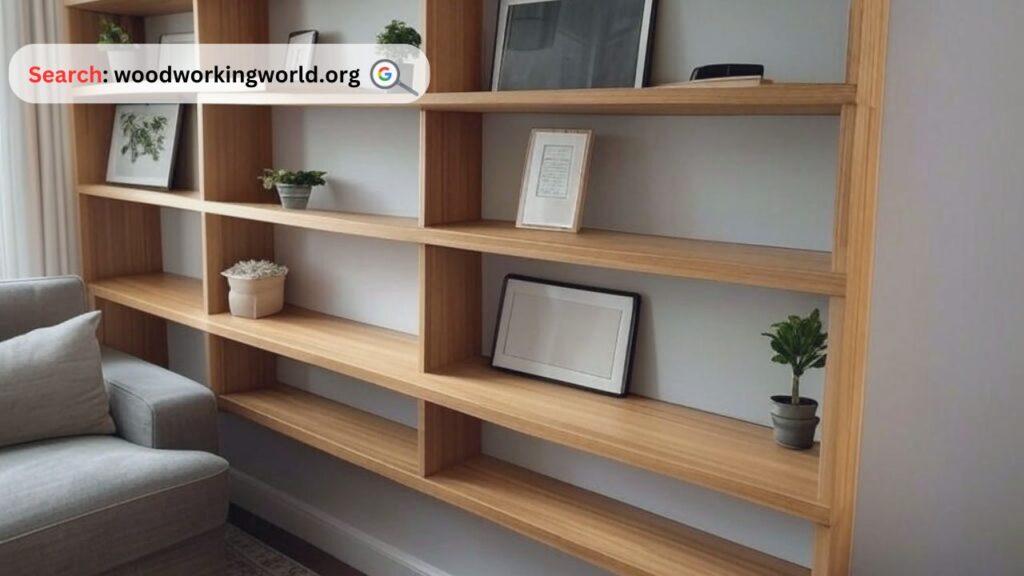Upgrade your living room with stylish floating shelves! Maximize storage while adding a modern touch. Discover the best designs and tips for your space.
In today’s modern homes, functionality and aesthetics go hand in hand. One of the best ways to achieve both is through floating shelves for the living room. These stylish storage solutions not only provide extra space but also enhance the overall appeal of your interior decor.

Floating shelves come in various styles, materials, and designs, making them a versatile addition to any living room. Whether you want to display books, decorative items, or even store everyday essentials, floating shelves can be the perfect choice. In this guide, we will explore the benefits, installation process, best styles, and common FAQs related to floating shelves.
Benefits of Floating Shelves
1. Space Optimization
Floating shelves help in utilizing vertical space efficiently, especially in small living rooms where floor space is limited.
2. Aesthetic Appeal
They provide a sleek, modern look, making your living room feel more organized and stylish.
3. Versatility
Available in multiple materials like wood, metal, or glass, floating shelves can complement any decor style, from rustic to contemporary.
4. Easy Maintenance
Since they are wall-mounted, floating shelves are easy to clean and maintain compared to bulky cabinets or bookshelves.
5. Customizability
They can be arranged in different patterns and heights to create a unique visual statement.
Build 16,000+ Projects with Step-by-Step Plans—No Big Workshop or Costly Tools Needed! Start Now!
Step-by-Step Guide: Installing Floating Shelves
Installing floating shelves may seem like a daunting task, but with the right tools and approach, you can do it yourself. Follow these steps:
Step 1: Gather the Necessary Tools
- Floating shelf kit
- Level
- Measuring tape
- Drill
- Screws and anchors
- Stud finder
- Pencil
Step 2: Choose the Placement
Decide where you want to install the shelves. Use a pencil and measuring tape to mark the placement. Ensure proper spacing between the shelves if installing multiple units.
Step 3: Find the Wall Studs
Using a stud finder, locate the wall studs. Floating shelves should ideally be anchored into studs for maximum stability. If no studs are available, use wall anchors to secure the shelf properly.
Step 4: Drill Holes for Brackets
Drill pilot holes at the marked spots. Insert the wall anchors (if needed) and screw in the brackets securely.
Step 5: Mount the Shelf
Slide the shelf onto the brackets and ensure it is level before securing it with screws.
Step 6: Decorate & Style
Once installed, arrange books, plants, or decorative pieces on the shelves to enhance the look of your living room.
Expert tips on Woodworking 🌿📦 Watch now!

Floating Shelf Material Comparison Table
| Material | Pros | Cons |
|---|---|---|
| Wood | Durable, classic look, customizable | Can be heavy, requires maintenance |
| Glass | Sleek, modern, lightweight | Fragile, limited weight capacity |
| Metal | Industrial look, strong | Prone to rust if not treated properly |
| MDF | Affordable, variety of finishes | Less durable than solid wood |
Best Floating Shelf Styles for Living Rooms
1. Minimalist Wooden Shelves
Perfect for a clean and modern look, these shelves work well in Scandinavian or contemporary-style living rooms.
2. Industrial Metal Floating Shelves
Ideal for urban and loft-style spaces, metal shelves offer a rugged and industrial appeal.
3. Glass Floating Shelves
For those who prefer a light and airy feel, glass shelves add elegance and modern sophistication.
4. Rustic Floating Shelves
Made from reclaimed wood, these shelves add a warm and natural touch to any living room.
5. Corner Floating Shelves
Maximizing unused corners, these shelves are great for small living rooms or to create an interesting visual element.
Styling Tips for Floating Shelves
- Use a mix of books and decorative objects to avoid a cluttered look.
- Add greenery like small potted plants or hanging vines for a fresh feel.
- Create symmetry by balancing items on both ends of the shelf.
- Layer different heights using a combination of tall and short items.
- Use LED strip lights underneath for a subtle and warm ambiance.

Quote of the Day:
“Your home should tell the story of who you are and be a collection of what you love.” – Nate Berkus
Frequently Asked Questions (FAQs)
Q1: How much weight can floating shelves hold?
A: The weight capacity varies by material and installation method. On average, properly installed shelves can hold 15-30 lbs.
Q2: Can floating shelves be installed on drywall?
A: Yes, but it is recommended to use wall anchors or attach them to wall studs for better support.
Q3: What is the best height for installing floating shelves?
A: The standard height is 4-5 feet from the floor, but it can vary based on personal preference and ceiling height.
Q4: How do I prevent floating shelves from sagging?
A: Secure them to wall studs and avoid overloading them with heavy items.
Q5: Are floating shelves easy to remove?
A: Yes, they can be removed by unscrewing the mounting brackets, but you may need to patch holes afterward.
Conclusion
Floating shelves are a fantastic way to add storage and style to your living room. With various materials, styles, and customization options available, they can be tailored to suit any home decor. Whether you prefer a modern, rustic, or industrial look, floating shelves provide a practical and aesthetically pleasing solution. Follow the installation guide, explore different styles, and make the most of your living space with stylish storage solutions!
Click To Order Teds Woodworking With A 60-Money-back Guarantee From – Official Website